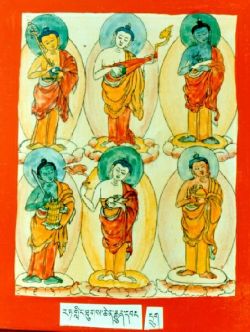Forty-two peaceful deities 四十二寂靜尊(文武百尊之「文尊」)
The forty-two peaceful deities (Tib. shyiwé lha shyé nyi; Wyl. zhi ba'i lha zhe gnyis) belong to the mandala of the Hundred Peaceful and Wrathful Deities, and feature in several practices and cycles of teachings, most notably the Tibetan Book of the Dead and the Guhyagarbha Tantra. They are:
目錄
- 1 1) Samantabadra 普賢王如來
- 2 2) Samantabadri 普賢王如來佛母
- 3 3-7) The Five Male Buddhas of the Five Families 五方佛
- 4 8-12) The Five Female Buddhas of the Five Families 五方佛母
- 5 13-20) The Eight Male Bodhisattvas 八大菩薩
- 6 21-28) The Eight Female Bodhisattvas 八大女菩薩/八大供養天女
- 7 29-34) The Six Munis 六能仁
- 8 35-38) The Four Male Gate Keepers 護門四王
- 9 39-42) The Four Female Gate Keepers 四守門女/四方守護明母
- 10 Further Reading
1) Samantabadra 普賢王如來
Samantabhadra 普賢王如來 (Wyl. kun tu bzang po);
2) Samantabadri 普賢王如來佛母
Samantabhadri 普賢王如來佛母 (Wyl. kun tu bzang mo);
3-7) The Five Male Buddhas of the Five Families 五方佛
Buddhas of the five families (Skt. jinakula; Tib. རྒྱལ་བ་རིགས་ལྔ་, Wyl. rgyal ba rigs lnga) — the five peaceful buddhas of the Sambhogakaya: 五佛部之佛-五位寂靜相報身佛。
- Vairochana, buddha family 毘盧遮那佛/大日如來,佛部
- Akshobhya, vajra family 阿閦佛/不動佛,金剛部
- Ratnasambhava, ratna family 寶生佛,寶部
- Amitabha, padma family 阿彌陀佛/無量光佛,蓮華部
- Amoghasiddhi, karma family 不空成就佛,事業部/羯摩部
8-12) The Five Female Buddhas of the Five Families 五方佛母
The five female buddhas of the five families, also known as the five mothers (Wyl. yum lnga) are:
- Dhatvishvari 金剛界自在母(大日如來佛母) (Skt.; Tib. དབྱིངས་ཕྱུག་མ་, Ying Chukma) also known as Vajra Datvishvari or White Tara, the consort of Vairochana, who represents the purity of the element space(大日如來佛母),或說白度母,空大的淨相
- Buddhalochana 慧眼佛母(不動佛的佛母) (Skt.; Tib. སངས་རྒྱས་སྤྱན་, Sangyé chenma) the consort of Akshobhya, who represents the purity of the element earth(阿閦佛佛母),地大的淨相
- Mamaki 瑪瑪姬佛母(寶生佛佛母) (Skt.; Tib. མ་མ་ཀི་, Mamaki) the consort of Ratnasambhava, who represents the purity of the element water(寶生佛佛母),水大的淨相
- Pandaravasini 白衣佛母(阿彌陀佛佛母) (Skt.; Tib. གོས་དཀར་མོ་, Gökarmo) the consort of Amitabha, who represents the purity of the element fire(阿彌陀佛佛母),火大的淨相
- Samayatara 三昧耶度母 (Skt.; Tib. དམ་ཚིག་སྒྲོལ་མ་, Damtsik Drolma) also known as Green Tara, the consort of Amoghasiddhi, who represents the purity of the element wind(不空成就佛佛母),或說綠度母,風大的淨相
13-20) The Eight Male Bodhisattvas 八大菩薩
Eight Great Bodhisattvas, or 'Eight Close Sons' (Skt. aṣṭa utaputra; Tib. ཉེ་བའི་སྲས་བརྒྱད་, Wyl. nye ba'i sras brgyad) — the main bodhisattvas in the retinue of Buddha Shakyamuni:
| This section contains Tibetan script. Without proper Tibetan rendering support configured, you may see other symbols instead of Tibetan script. |
- Mañjushri, འཇམ་དཔལ་ or འཇམ་དཔལ་དབྱངས་ 文殊師利(妙吉祥)菩薩,
- Avalokiteshvara, སྤྱན་རས་གཟིགས་ 觀世音菩薩,
- Vajrapani, ཕྱག་ན་རྡོ་རྗེ་ 金剛手(大勢至)菩薩,
- Maitreya, བྱམས་པ་མགོན་པོ་ 彌勒菩薩,
- Kshitigarbha, ས་ཡི་སྙིང་པོ་ or སའི་སྙིང་པོ་ 地藏菩薩,
- Akashagarbha, ནམ་མཁའི་སྙིང་པོ་ 虛空藏菩薩,
- Sarvanivaranavishkambhin, སྒྲིབ་པ་རྣམ་སེལ་ 除蓋障菩薩, and
- Samantabhadra, ཀུན་ཏུ་བཟང་པོ་ 普賢菩薩.
Read more about them
21-28) The Eight Female Bodhisattvas 八大女菩薩/八大供養天女
The eight female bodhisattvas (Wyl. byang chub sems ma brgyad) are also referred to as the eight offering goddesses. They are the consorts of the eight great bodhisattvas:
八大菩薩的明妃[譯註:嬉女、鬘女、歌女、舞女、花女、香女、燈女、塗女,皆屬三十七曼達供養]。
- Goddess of Beauty 嬉媚天女(Skt. Lāsyā; Tib. Gekpama; Wyl. sgeg pa ma) the consort of Kshitigarbha 地藏菩薩的明妃,又稱金剛媚母
- Goddess of Garlands 持鬘天女(Skt. Mālyā; Tib. Trengwama; Wyl. phreng ba ma) the consort of Akashagarbha 虛空藏菩薩的明妃,又稱金剛鬘母
- Goddess of Song 歌詠天女(Skt. Gītā; Tib. Luma; Wyl. glu ma) the consort of Vajrapani 金剛手(大勢至)菩薩的明妃,又稱金剛聲母
- Goddess of Dance 舞蹈天女(Skt. Nirtī; Tib. Garma; Wyl. gar ma) the consort of Avalokiteshvara 觀世音菩薩的明妃,又稱金剛舞母
- Goddess of Flowers 供花天女(Skt. Pūṣpā; Tib. Metokma Wyl. me tog ma) the consort of Sarvanivaranavishkambhin 除蓋障菩薩的明妃,又稱金剛華母
- Goddess of Incense 薰香天女(Skt. Dhupā; Tib. Dukpöma; Wyl. bdu spos ma) the consort of Maitreya 彌勒菩薩的明妃,又稱金剛香母
- Goddess of Light 明燈天女(Skt. Alokā; Tib. Marmema or Nangselma; Wyl. mar me ma) the consort of Samantabhadra 普賢菩薩的明妃,又稱金剛燈母
- Goddess of Perfume 塗香天女(Skt. Gandhā; Tib. Drichabma; Wyl. dri chab ma) the consort of Mañjushri 文殊菩薩的明妃,又稱金剛塗母
Symbolically they represent the pure state of sense objects.
象徵感官對境的淨相。
29-34) The Six Munis 六能仁
The Six Munis (Skt.; Tib. Tubpa Druk; Tib. ཐུབ་པ་དྲུག་, Wyl. thub pa drug) are the supreme nirmanakaya buddhas for each of the six classes of beings. They are:
相應度脫六道眾生的無上化身佛。分別是:
- Indra Kaushika 天道能仁─天帝帝釋(Skt.; Tib. དབང་པོ་བརྒྱ་བྱིན་, Wangpo Gyajin; Wyl. dbang po brgya byin) for the god realms
- Vemachitra 非天能仁─綺畫修羅王(毗摩質多)(Skt. Vemacitra; Tib. ཐགས་བཟང་རིས་, Taksangri; Wyl. thags bzang ris) for the demi-gods or asura realms
- Shakyamuni 人道能仁─釋迦牟尼(Tib. ཤཱཀྱ་ཐབ་པ་, Wyl. shAkya thub pa) for the human realm
- Shravasingha or Dhruvasiṃha 旁生道能仁─堅淨師子(Skt.; Tib. སེང་གེ་རབ་བརྟན་, Sengé Rabten; Wyl. seng ge rab brtan) for the animal realm
- Jvālamukhadeva 餓鬼道能仁─焰口天(Skt.; Tib. ཁ་འབར་དེ་བ་, Khabar Dewa; Wyl. kha ‘bar de ba) for the preta realms
- Dharmarāja 地獄道能仁─法王(Skt.; Tib. ཆོས་ཀྱི་རྒྱལ་པོ་, Chökyi Gyalpo; Wyl. chos kyi rgyal po) for the hell realms
[譯註:能仁也可以直接翻譯為佛陀,堅淨一詞出於《地藏占察經》當中「堅淨信菩薩」的譯詞;感謝敦珠貝瑪南嘉師兄指導。2015.05.27更正]
35-38) The Four Male Gate Keepers 護門四王
The four male gatekeepers (Wyl. sgo ba yab bzhi) are:
- Achala, guarding the east gate (or Vijaya, or Mahabala?) 不動明王(或說尊勝明王、大力明王),守護東門
- Yamantaka, guarding the south gate 閻魔敵明王/大威德金剛,守護南門
- Hayagriva, guarding the west gate 馬頭明王,守護西門
- Amritakundali, guarding the north gate 甘露漩明王,守護北門
39-42) The Four Female Gate Keepers 四守門女/四方守護明母
The four female gatekeepers (Wyl. sgo ma bzhi) are:
- Ankusha (Skt. Aṅkuśā; Wyl. lcags kyu ma or rta gdong ma) also called 'Horse Face' or 'Iron Hook', guarding the east gate and in union with Vijaya (or Achala?) 金剛鐵鉤女,又稱馬面或鐵鉤,守護東門,與尊勝明王(或說不動明王)雙運
- Pasha (Skt. Pāśā; Wyl. zhags pa ma or phag gdong ma) also called 'Sow Face' or 'the Noose', guarding the south gate and in union with Yamantaka 金剛繩女,又稱亥母面或繩索套,守護南門,與閻魔敵明王雙運
- Shrinkhala (Skt. Śriṅkhalā; Wyl. lcags sgrog ma or seng gdong ma) also called 'Lion Face' or 'Iron Chain', guarding the west gate and in union with Hayagriva 金剛鐵鍊女,又稱獅面或鐵鍊,守護西門,與馬頭明王雙運
- Ghanta (Skt. Ghaṇtā; Wyl. dril bu ma or spyang gdong ma) also called 'Wolf Face' or 'the Bell', guarding the north gate and in union with Amritakundali. 金剛鈴女,又稱狼面或鈴,守護北門,與甘露漩明王雙運
These deities are also described as the deities of the three seats.
Further Reading
- Thinley Norbu, The Small Golden Key (Shambhala Publications, 1999), pages 72-81.
